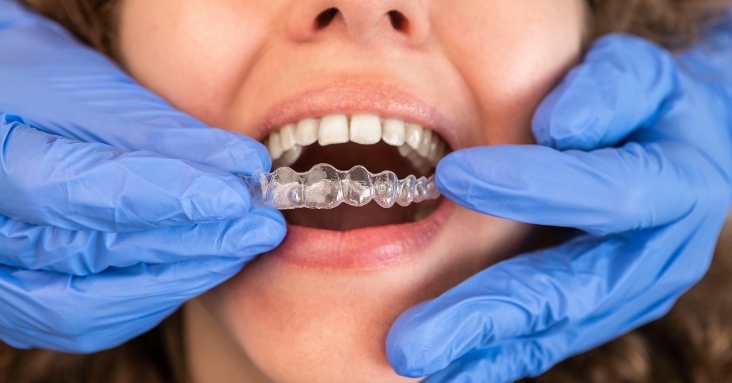Emergency & New Patients Welcome!

You notice it every time you smile in the mirror—that little space between your teeth. It’s subtle, yet it somehow grabs your attention more than it should. Some call it a charming feature. Others call it a distraction. Either way, if you’re here, you’re likely wondering if there’s a low-key, modern solution to close that gap without wires or brackets.
Here’s the twist: Traditional braces aren’t the only fix anymore. Enter Invisalign. You’ve heard the name, seen the commercials, and maybe even know a friend who raves about it. But can it fix that gap between your teeth? Not just disguise it—but move your teeth, align your bite, and close the space for good?
Let’s break it down in a way that doesn’t feel like a textbook or a sales pitch. Instead, think of this as a friendly conversation about what’s possible, what’s smart, and what works.
What’s Going On With That Tooth Gap?
Tooth gaps—also called diastema—can show up for all kinds of reasons. It’s not just about looks. In many cases, these spaces are caused by:
- A mismatch between tooth size and jawbone width
- Missing teeth that throw off alignment
- Habits like thumb-sucking or tongue thrusting
- Gum disease that shifts teeth subtly over time
So, while the gap might seem like a minor issue, it often reflects a bigger story about how your teeth and jaws work together. And that’s where Invisalign enters the chat.
How Invisalign Works Behind the Scenes?
Think of Invisalign as a clear, customized strategy for your teeth. No metal, no wires—just a series of nearly invisible aligners that gently nudge your teeth into a better position over time.
Here’s how the magic happens:
- Digital Mapping: Your teeth get scanned, not molded. The result? A 3D image that lays out a custom roadmap.
- Custom Aligners: You’ll wear each aligner tray for about 1–2 weeks. Each one shifts your teeth slightly closer to their ideal position.
- Gradual Movement: Unlike braces that pull, Invisalign uses controlled pressure to guide your teeth. It’s like a GPS for your smile.
- Discreet and Comfortable: No food restrictions, no visible hardware, and far fewer dental visits.
If you’re thinking, “That sounds good in theory”, but does it close gaps? You’re not alone. Let’s dig into that.
Yes, Invisalign Can Close Gaps (and Here’s Why)
Invisalign is actually well-known for treating mild to moderate spacing issues. Whether it’s a small gap between your front teeth or more than one space across your smile, Invisalign is designed to bring those teeth closer—gently and predictably.
Why it works:
- The aligners apply just the right pressure in specific areas to move teeth horizontally.
- The system can even rotate and tilt teeth when needed, depending on your unique case.
- Tooth-colored attachments can be added to enhance grip and movement, especially when closing wider gaps.
You don’t need to commit to years of metal braces to close a space. Invisalign offers a more subtle path—with real results.
Not All Gaps Are Created Equal
Now, here’s the part nobody tells you upfront: not every tooth gap is treated the same. Not every gap is best solved with Invisalign—at least, not on its own.
Some things your dental provider will consider:
- Gap Size: Smaller gaps? Invisalign is usually a great fit. Larger ones may need extra steps.
- Gum Health: If gaps are caused by gum disease or bone loss, that needs to be addressed first.
- Tooth Shape: If teeth are too narrow or small, cosmetic bonding or veneers might be part of the plan.
- Underlying Bite Issues: If your bite’s out of sync, the gap might reappear unless the full alignment is corrected.
That’s why a personalized treatment plan matters. Invisalign isn’t a one-size-fits-all fix, but in many cases, it is the answer.
Real-Life Perks of Closing That Gap
Sure, the cosmetic benefit is huge. A more aligned smile can boost your confidence, especially in photos or social situations. But there’s more to it than looks.
Here’s what else happens when that gap disappears:
- Better Bite Function: Teeth that sit closer together usually chew more efficiently.
- Healthier Gums: Spaced teeth are harder to keep clean, so closing the gap helps reduce the risk of buildup and inflammation.
- No More Whistling: Yes, tooth gaps can cause speech quirks—and fixing them may help your pronunciation sound smoother.
- Balanced Pressure: When teeth are aligned, they share chewing forces evenly, which can reduce wear and tear.
What Does the Invisalign Process Feel Like?
If you’re someone who doesn’t want dental treatment to take over your life, this is where Invisalign shines.
People across the U.S. love it for good reason:
- You Take Them Out to Eat: No restrictions. Eat popcorn. Chew gum. Enjoy steak.
- Cleaning is a Breeze: Brush and floss like normal—no need to navigate around wires.
- Almost Invisible: Most people won’t even notice you’re wearing them.
- Shorter Check-Ins: Visits are spaced out and quick, usually under 30 minutes.
It’s a low-drama, high-impact treatment that blends into your routine instead of disrupting it.
So, can Invisalign fix the gap between your teeth? For many people, the answer is a confident yes. But here’s the real takeaway: It’s not just about closing a space. It’s about transforming how you feel when you smile.
Choosing Invisalign isn’t just a cosmetic decision—it’s a step toward healthier alignment, cleaner teeth, and a smile that feels more like you.
If your gap makes you self-conscious or your bite feels off, Invisalign might be exactly the option worth exploring. You deserve a solution that works quietly in the background while your smile takes center stage.

